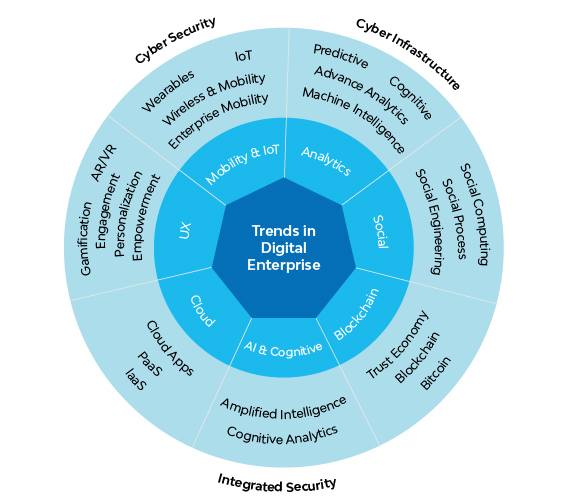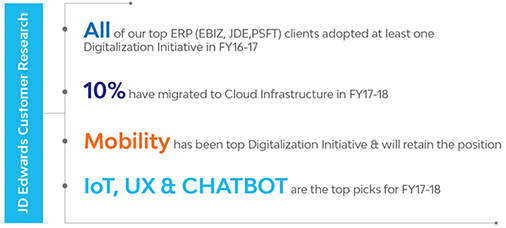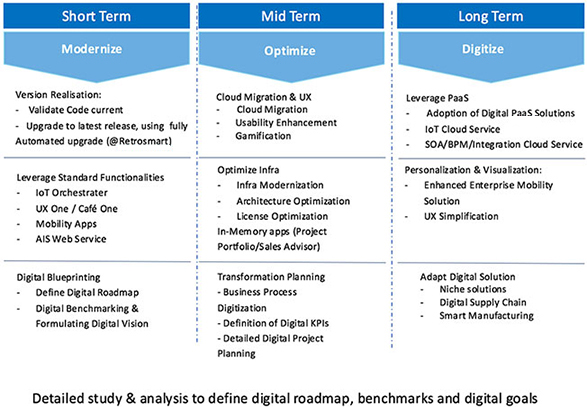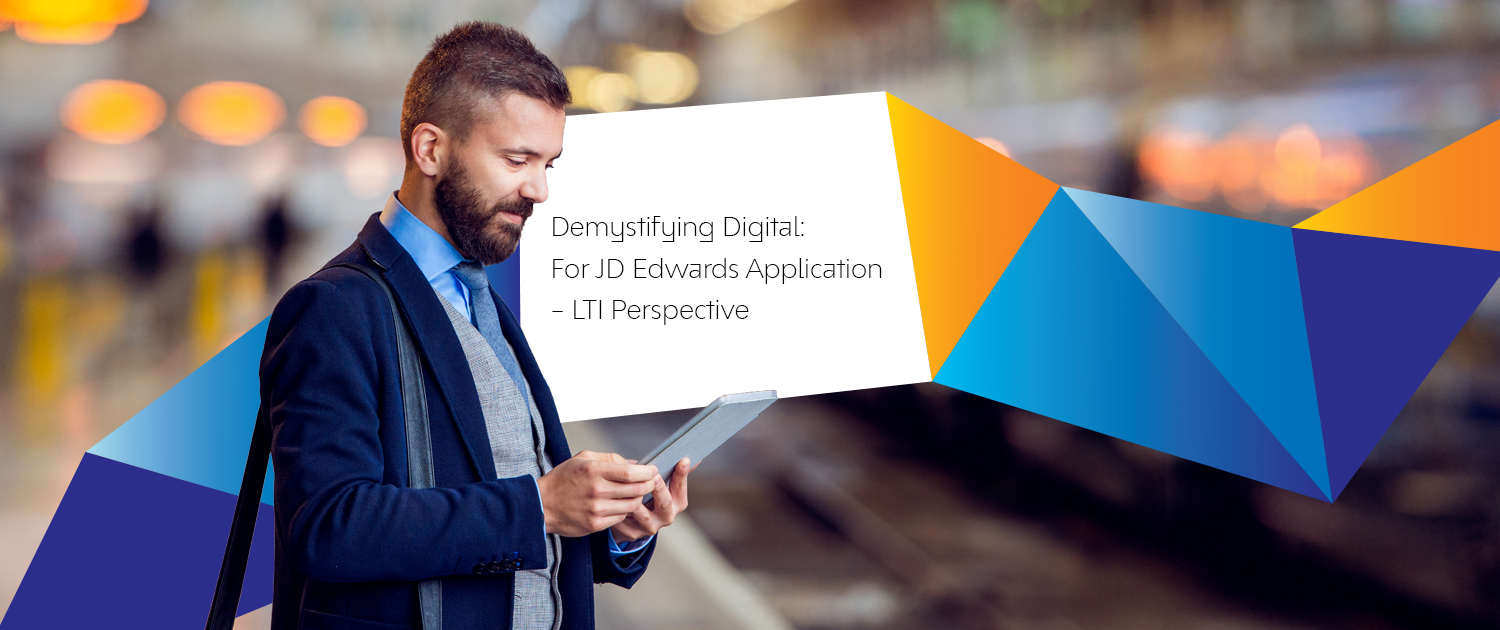Demystifying Digital: For JD Edwards Application
We are all witnessing a digital wave, which is transforming our life in multiple ways, including the way we do our business. Digital transformation is disrupting businesses, and most of the organizations are pondering over methods to make themselves digital-ready. Digital, by itself, is confusing to many; however by enlarge, the “Digital Map” of an enterprise can be depicted as per the figure 1 below:

(Figure 1)
Over the last several years, most of the organizations have spent millions of dollars on their “Enterprise Applications”, by way of business standardisations, de-customisations, code-current, roll-outs and costly upgrades. Many CIOs are unsure of the way forward, having spent these dollar amounts in upgrading and maintaining expensive applications. Technology obsolescence, coupled with Cloudisation, is rapidly diminishing the value of investments made in enterprise applications; many CIOs are embarking on a path of accelerated “Digital Adaptation”, such as migrating to SaaS applications, or adapting niche products to digitize business processes. Many times, such ad-hoc steps are at best some patch work in the overall digital journey, with a result that all such investments do not yield as much returns as envisaged before. It is therefore ideal to create a “Digital Roadmap”, with a clear vision on digitising business processes such that significant benefits are derived post implementation of digital technologies.
So while CIOs grapple with a Hobson’s choice of either replace the conventional on-premise applications with modern Cloud Apps, or don’t get on this path of digital technology adaption, we have created a “MOD framework”, which is based on the principle of Modernize, Optimize and Digitize legacy applications. As part of this framework, following specific recommendations are being proposed to all those global users who are using J D Edwards as an ERP. These recommendations are based on inherent features provided by JDE in the latest release (release 9.2), as well as other PaaS products being offered by Oracle Corporation.
Our Marketing group conducted a secondary research by speaking to many firms, who are using JDE and the feedback collected was very revealing. The findings are as per the Figure 2 below:

(Figure 2)
Based on our assessment of the market, we recommend a three-phased approach for our JDE customers to define and execute their “Digital Journey”, as described in Figure 3 below. LTI has an offering for JDE customers around this MOD framework, which can be leveraged by JDE customers worldwide.

(Figure 3)
LTI has developed offerings to specific JDE customers as above helping customers to transform their business to make it competitive, smart and contemporary. The three phases of digital transformation are described as below:
Phase 1
Modernize
CIOs have an option to firstly upgrade the JDE application to its latest release level. There are fully automated methods such as leverage Retrosmart (LTI Proprietary tool) to minimise the efforts by as much as 40%. This also enables users to not just leverage the next-generation functionality, but also helps in minimizing the cost of support payable to Oracle (in case you are on older version, which is on extended support of Oracle).
As an immediate step, following features can be enabled to give instant benefit to JDE users. Some of these functionalities are:
- IoT Orchestrator for implementing predictive maintenance solution
- UX One (which is a later version of CAFE1 or Composite Application Framework), which has features such as:
- Watchlist, alerts
- Media Object Viewer
- One View reporting
- Dynamic URL linking through Café1
- Mobile location awareness, proximity
- Delivered Mobility for transactions, enabling users to transact using smart cell phones. Many of the apps are quite basic and need enhancements.
As the above is getting implemented, a detailed assessment of overall digital roadmap can be formulated. LTI, as an organization, has helped many firms in digitising their operations and creating highly competitive and futuristic business models.
Phase 2
Optimize
We strongly recommend customers to migrate their JDE infrastructure, to either public cloud such as Oracle Cloud service, or to any other competing cloud service provider. This helps in cleaning up companies’ financial books by unlocking infrastructure assets, as well as, giving flexibility to expand the application usage considerably without having to worry about underlying infrastructure. LTI has helped several companies migrate their JDE infrastructure to cloud, and has an accelerated migration methodology.
Apart from the Cloud migration, once we have modernise JDE application, there are multiple opportunities to maximise JDE investments. Some of these areas that can give benefit are:
- Infrastructure modernisation that can help you optimise licenses. This offering is predominantly for those, who are not migrating to Cloud, and are continuing with On-premise infrastructure. License optimisation can come in as a significant advantage, if one can optimise number of chores and processors.
- Oracle JDE have some cool offerings based on In Memory Computing Technology. These offerings cover:
- In-memory project portfolio advisor
- In-memory sales advisor
Both the offerings can give significant advantage to business.
- LTI has co-developed “Smart Manufacturing” solutions jointly with Oracle. These are cool offerings and can give significant benefit to manufacturing organization.
- Another digital offering is In-memory Cost Management, which is developed by Oracle and is available on “per 1000 item” basis. LTI has developed adapter for this solution, which can give extremely short ROI to customers using this solution.
LTI Digital Consulting would also be defining clear steps to digitize business processes as part of this phase. Specific digital initiatives will be identified aligned with Oracle PaaS platform.
Phase 3
Digitize
One of the most powerful propositions, is to leverage Oracle PaaS offerings, coupled with JDE. LTI has implemented several solutions to digitize business processes, and also to create paperless operations for our customers by leveraging SOA/BPM Cloud services. One example of such a solution could be Accounts Payable automation, which can be categorised as Robotic Process Automation.
LTI has established an Enterprise Mobility platform, which has significant improvements in terms of transaction screens. This gives immense benefit to users as the screens are intuitive, simple and easy to transact. LTI has seen significant productivity improvement in JDE users by leveraging this Enterprise Mobility platform, which is developed on Oracle Mobile Cloud Service offering.
LTI has also developed many other niche solutions for JDE users, such as Fleet Management (built-on Oracle IoT Cloud service integrated with JDE, as well as OTM), and Smart Water processing (Leverages Oracle IoT Cloud service). There are many others frameworks built, such as Industrial Pump Automation and Field Service management.
LTI has come up with Cognitive/AI-based “Mosaic Run” model, which eliminates humans to solve recurring tickets. The savings in reducing run cost can actually be used to fund business transformation by adapting digital technologies.
Conclusion
We are all part of fast-changing world with onslaught of digital technologies. Almost all the organizations have limited budgets and every dollar spent needs to be worth its while. The MOD framework of LTI is ideal for JDE users worldwide, which can help in truly transforming the business operations, and at the same time giving significant productivity benefit. MOD framework is based on the paradigm that “Reduce spend on run/maintain to fund transformation”. We strongly encourage JDE users worldwide to work on some of the recommendations above, and adapt digital technologies rapidly but with minimum cost.
More from Dr. Arvind Ankalikar
Latest Blogs
Core banking platforms like Temenos Transact, FIS® Systematics, Fiserv DNA, Thought Machine,…
We are at a turning point for healthcare. The complexity of healthcare systems, strict regulations,…
Clinical trials evaluate the efficacy and safety of a new drug before it comes into the market.…
Introduction In the upstream oil and gas industry, drilling each well is a high-cost, high-risk…




